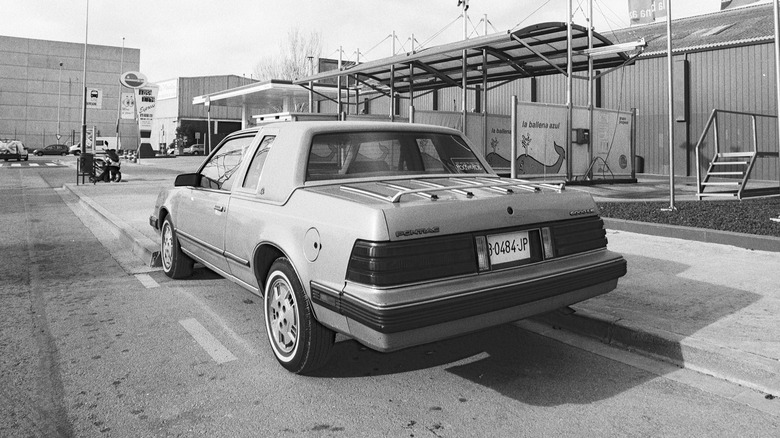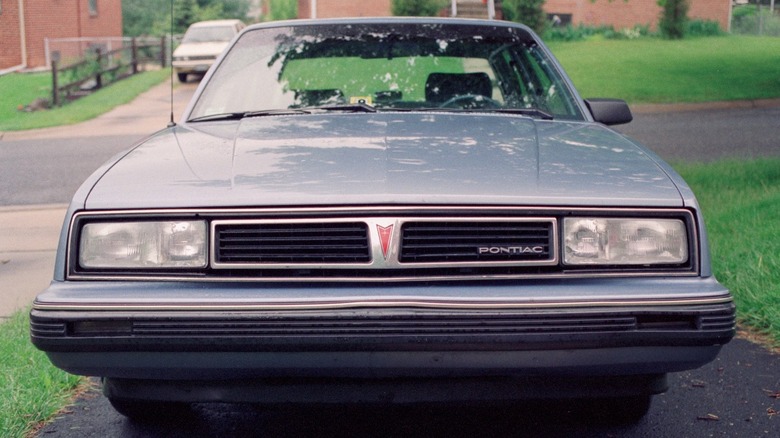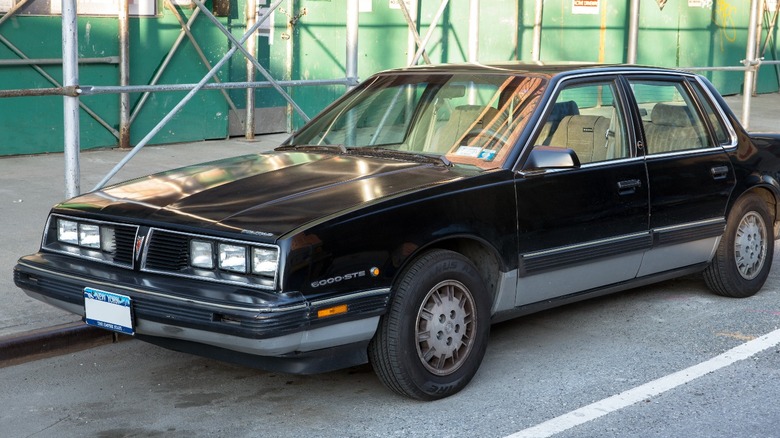Pontiac 6000: Was It As Bad As We Remember?
The early 1980s weren't a great time for U.S.-built cars. Compared to the flamboyant, fire-spitting, and fast muscle cars of the 1960s, the offerings from major U.S. automakers in the late 1970s and early 1980s looked like corporate suits — soulless, stiff, and boring. There were multiple reasons for the dramatic shift in attitude, with the 1973 and 1979 oil crises, increasingly strict emissions requirements, and serious foreign competition being the main catalysts of the downward spiral. Those factors created a perfect storm for underpowered and dull cars to flood U.S. showrooms until 1983, when new engine technology eventually made cars powerful again and the 'malaise era' came to a close.
Pontiac was no exception to the norm during the period, falling a long way from their historic highs in the 1960s with the legendary Pontiac GTO and Firebird. By the early 1980s, Pontiac, under the GM umbrella, was forced to downsize their cars and prioritize economy over everything else — ironic for a brand whose slogan was "we build excitement" at the time. Along with three other GM divisions — including Chevrolet, Buick, and Oldsmobile — Pontiac was given a standardized front wheel drive chassis to work with in 1982 called the A-body platform. While none of the other manufacturers made very good use of the chassis, Pontiac transformed the platform into something special for the time. The model was called the Pontiac 6000, and it was called by many one of the best cars to come out of Detroit in the mid-1980s.
The Pontiac 6000 was an unlikely hero among front-drive disappointments
The GM A-body wasn't a platform to write home about. In fact, it was a reworked version of the front-wheel-drive X-body from the late 1970s that was so terrible that the NHTSA filed a lawsuit against GM due to its dangerous design. To say the least, A-body cars had the odds stacked against them from the beginning. In addition to the Pontiac 6000, the other A-bodies included the Chevrolet Celebrity, Buick Century, and Oldsmobile Cutlass Ciera. The Pontiac 6000 stood above the pack as the model that could actually compete with international competition.
A lot of that praise stemmed from the fact that the 6000 was the most 'sport-oriented' example of the A-body platform, with 'sport-oriented' being a relative term. The 1982 base model came equipped with the infamously characterless 2.5L Iron Duke four-cylinder with only about 90 horsepower on offer. That isn't the one that people remember, and the base 6000 essentially faded into obscurity with the rest of the sub-pars. In the A-car canon, people remember the Pontiac 6000 STE (or "Special Touring Edition"), which was truly an attempt to replicate European performance and luxury. Compared to the anemic base model, the STE received a Chevy-designed "high performance" 2.8-liter V6 that boasted 40 more horses than the Iron Duke, bringing output up to 130 horsepower. It also received sport suspension, sharper rack and pinion steering, a lower final drive ratio, and better tires. The performance-oriented changes made a difference, with the 6000 STE outperforming Dodge, Datsun, Toyota, and Volvo in a number of different performance and comfort categories in a 1983 Car and Driver test, trailing only behind Audi with their 5000S.
[Featured image by Chris Jantsch via Wikimedia Commons | Cropped and scaled | CC BY-SA 4.0]
The Pontiac 6000 evolved over the years but it wasn't enough to save the model
As the Pontiac 6000 STE continued to garner a positive reputation in the press and through word of mouth, it continued to receive revisions over its seven-year production run. Some of those changes came in the form of true performance-enhancing advancements, and others came in the form of shiny gimmicks. For example, the STE received four-wheel disc brakes in 1984, which made a difference in the STE's stopping power. That was also the same year that the STE received a digital dash and tachometer.
In the first two years of its production, the 6000 STE's 2.8L V6 used two-barrel carburetors, which were upgraded to fuel injection in 1985, and in the following few years after that, the STE received anti-lock brakes, an upgraded four-speed automatic transmission (in addition to an optional 5-speed manual), and rear self-leveling suspension. The 1988 model year also saw the addition of a new 140-horsepower 3.1-liter V6 and all-wheel drive. The revisions were well received by automotive media, with the STE earning spots on Car and Driver's 10 Best Cars list between 1983 and 1985.
While the 6000 STE was a standout model in the GM A-body lineup and a solid car even in an international context, its constant upgrades and positive reviews weren't enough to get cars off showroom floors. 1986 was the best year for Pontiac 6000 sales at 211,375 units, which fell to only 138,489 units just a year later. A big reason for the 6000's decline was the introduction of the Ford Taurus, which took the 6000's spot as the media's favorite American model in 1986.
[Featured image by Mr.choppers via Wikimedia Commons | Cropped and scaled | CC BY-SA 3.0]


